Darrel's Immigrant Ship Page
RMS Oceanic
1899-1914 (1924)
The second ship of the line
to be named after the company, Oceanic was launched from the ways of
Harland and Wolff on 14 January 1899. Her construction had been partially
subsidized by the Admiralty, thus her decks were strengthened to accommodate gun
mounts, coal bunkers and bulkheads were placed for maximum protection from
gunfire, specific speed and cruising ranges were met, and passenger spaces were
easily convertible into spaces for troop transport. Nonetheless, Oceanic's
size, sleek appearance, and luxury gave her titles such as "Ship of the Century"
and "White Star's Millionaire's Yacht."
Her appointments surpassed
the standards of luxury for her time. Her first class dining saloon could seat
over 400 in one sitting and its ceiling was adorned with a 21 square foot dome.
The saloon was lit from a row of oversized portholes on each side of the ship.
Where there were no portholes, there were electric lamps. In total, Oceanic
had 2,000 electric lamps. Another feature of the ship that was adored by her
passengers was the library, which many thought was the most beautiful of her
rooms, which was topped with a beautiful glass dome. She could carry 410 in
first class, 300 in second, and 1,000 in steerage.
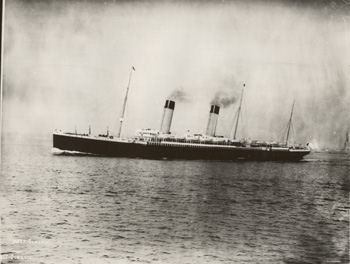
She was delivered to White
Star on 26 August 1899 and would remain the largest existing ship in the world,
the first to surpass the length (although not gross tonnage) of Great Eastern,
until the arrival of Celtic in 1901. Oceanic's maiden voyage
began on 6 September 1899, on the Liverpool to New York run. While Oceanic
was a fast ship, averaging 18.96 knots on reduced power on this voyage, she
never broke the record to take the Blue Riband. It is possible that she was
planned to be a record-breaker, but for some reason, possibly vibration, never
did. Instead, she was the precursor of White Star's slower, larger, and more
luxurious "Big Four," consisting of Celtic, Cedric, Baltic,
and Adriatic.
On 1 September 1901, because
of low visibility due to fog, Oceanic rammed and sank the British coaster
Kincora off Tuskar, killing seven.
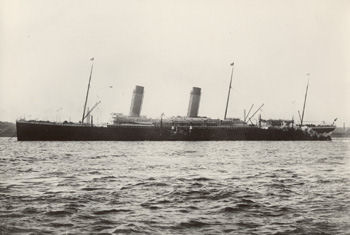
Even with the introduction
of the "Big Four," Oceanic remained the ship of the line until the
arrival of Olympic in 1911. Her speed and luxury made her very popular
with sophisticated travelers, among them International Mercantile Marine (IMM)
bankroller, Junius Pierpont Morgan.
A mutiny onboard occurred in
1905, resulting in the convictions of 33 stokers. Even with incidents such as
these, White Star director J. Bruce Ismay made sure that Oceanic was
repaired and back in tip-top shape as soon as possible as she was the last White
Star liner launched during his father's lifetime. Originally, Oceanic
was to have a sister ship, to be named Olympic or possibly Gigantic,
but this sister was never built, and the name Olympic would be reserved
for another, much larger and more luxurious ship.
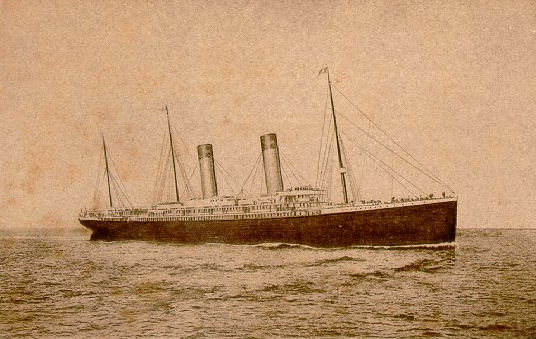
Even with the introduction
of the "Big Four," Oceanic remained the ship of the line until the
arrival of Olympic in 1911. Her speed and luxury made her very popular
with sophisticated travelers, among them International Mercantile Marine (IMM)
bankroller, Junius Pierpont Morgan.
A mutiny onboard occurred in
1905, resulting in the convictions of 33 stokers. Even with incidents such as
these, White Star director J. Bruce Ismay made sure that Oceanic was
repaired and back in tip-top shape as soon as possible as she was the last White
Star liner launched during his father's lifetime. Originally, Oceanic
was to have a sister ship, to be named Olympic or possibly Gigantic,
but this sister was never built, and the name Olympic would be reserved
for another, much larger and more luxurious ship.
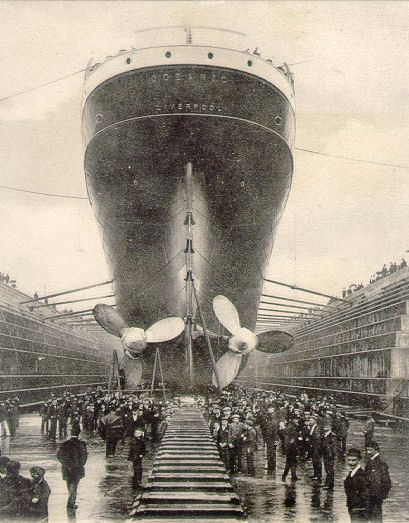
White Star's eastern terminus for
the North Atlantic route was moved to Southampton in 1907, and 19 June that year
marked Oceanic's first voyage on the Southampton to New York run. In
1911, during a thunderstorm a bolt of lightning struck the ship's foremast. The
impact was felt all over the ship. A nine-foot fragment of the mast then
crashed down on deck, sending splinters all over the open bridge and narrowly
missing the glass dome of the library. Her wireless was also put out of
commission for a short time.
The Great Coal strike of 1912
resulted in the temporary laying up of several I.M.M. ships, Oceanic in
Southampton being one of them, so that the new liner Titanic would have
enough coal for her maiden voyage. When Titanic left Southampton on 10
April 1912, then the largest liner in the world, the new liner's displacement
pulled Oceanic out of her berth so far that a 60-foot gangway linking her
to her pier fell into the sea. The ship tied just abeam of Oceanic,
New York, was pulled out of her berth, breaking ropes attempting to hold her
back, and almost collided with Titanic. Days later, while at sea
Oceanic would pick up a lifeboat (collapsible A) from the ill-fated larger
liner finding three bodies so badly decomposed that they had to be buried at sea
on the spot.
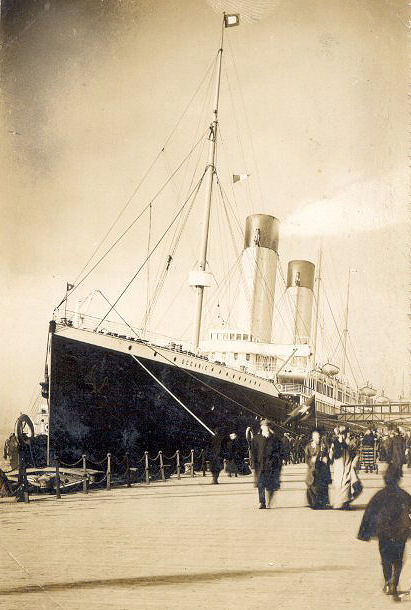
When Great Britain declared
war on Germany in August 1914, Oceanic was at sea, going from New York to
Southampton. When she reached the Irish coast, she was greeted by two Royal
Navy cruisers and escorted for the remainder of the voyage. She was quickly
converted to war service and commissioned as H.M.S. Oceanic upon her
arrival at Southampton. The conversion would take two weeks. She would be
captained by her master of two years, Henry Smith (unrelated to Titanic's
E.J.), and the Royal Navy's own William Slayter. Smith would be in command in
an advisory capacity, but Slayter was in nominal command of the ship and crew.
An unsubstantiated rumor
stated that Oceanic would be patrolling an exotic (and safe) Far Eastern
port, resulting in several of her civilian crew remaining aboard. Merchant
seamen who remained were joined with naval officers and ratings, resulting in
several misunderstandings between the two groups initially. When Oceanic
left Southampton on 25 August 1914, however, her destination would not be
Bombay, Rangoon, or Hong Kong, but rather north to Scapa Flow to join the 10th
Cruiser Squadron. There must have been some disappointment onboard when this
was found out.

Arriving at Orkeny, Oceanic
was sent to patrol the Western Approaches, west of Fair Isle. She then went to
make a courtesy call at Reykjavik, Iceland and returned to Scapa Flow where
gunnery practices for her inexperienced crew began. Several of the ship's
civilian crew was now composed of several Shetland Island fisherman.
Oceanic was to patrol
an 150-mile stretch of sea between Scotland and the Denmark's Faroe Islands,
making sure that passing ships' cargoes and passengers did not contain
contraband or German sympathizers.
So that gun crews watch
endings would not end at each morning's general alert, Slayter ordered the
ship's clock set back forty minutes. Now the ship had two times, Greenwich Mean
and ship's, for the ship's two captains and three crews. Needless to say, more
confusion resulted.
Informally, Smith and Slayter
agreed that the former would be in command during the day and the latter at
night, even though the two were still at odds over how to manage the ship.
Slayter, being of the Royal Navy, was in overall command. Slayter had
Oceanic search for German submarines and patrol craft around the island of
Foula. She would spend much of her time on zigzag courses to evade German
submarines. The duty of recording the course changes would be handled by David
Blair, originally second officer of Titanic, but was displaced with the
"demotion" of officer Charles Lightoller, who incidentally was now Oceanic's
first officer.

Foula was sighted on 7
September 1914, and she continued to zigzag despite thick fog. The fog cleared
up the next morning. By this time, Blair calculated that Oceanic was
well south of Foula. Slayter then ordered Oceanic on a course to take
her back to Foula before retiring. Blair made the calculations, and after that
was done, he too retired for a nap.
Smith arrived to look over
the chart while Blair napped and concluded that Oceanic was fourteen
miles to the south and west of Foula. Fearing that their course would result in
the ship's running aground on the reefs around the island, Smith ordered a
course change to the west to the open sea without consulting Slayter. When
Blair awoke and reported for duty, he suggested that soundings be taken to
determine the exact position of the ship, but Smith vetoed the idea.
Half-an-hour later, Foula was sighted dead ahead. Blair, either because the
complicated calculations he had to make or because of fatigue, had plotted
Oceanic off course. Smith turned the ship several points to starboard to
avoid the southern end of the reef known as Da Shaalds (The Shallows) and bring
the ship into a narrow channel between reef and island, the latter of which
Smith estimated to be four miles off.
Hearing the lookout's cry,
Slayter rushed to the bridge. Seeing that the ship was closer to Foula than
Smith had thought, Slayter ordered a sharp turned to starboard to leave the area
as soon as possible. At that moment, with a large amount of grinding,
Oceanic was pushed into Da Shaalds, stern first into the reef. The next
tide, instead of freeing her, drove her further into the reef.
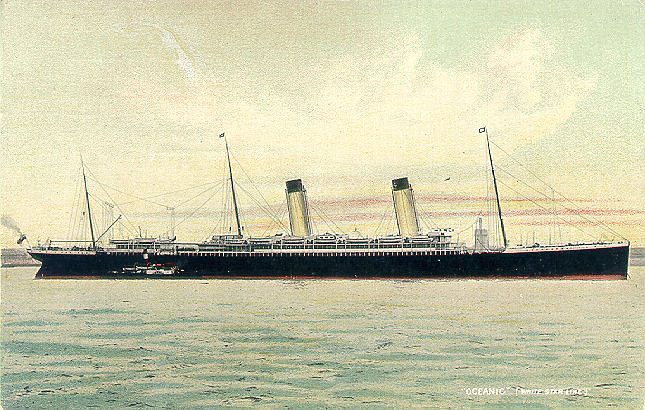
The Aberdeen trawler
Glenogil and the Royal Navy's H.M.S. Forward put lines around
Oceanic, but Oceanic was pushed in much too far. The tow lines
snapped and Oceanic stayed right where she was. Soundings then showed
that the double bottom was so badly breached that even if she were to be freed,
she'd sink. Orders to abandon ship were given late that afternoon. By evening,
all of the ship's 600 crew members were evacuated without incident, ferried to
other vessels standing by via lifeboats. She was declared a total loss on 11
September at age fifteen.
For the next three weeks, the
Admiralty salvage vessel Lyons recovered all guns, all but one of the gun
shields, and most of the ammunition among other naval fittings. There was a
long period of quiet around Foula afterwards, but then an incredibly fierce
storm struck on 29 September. On the morning of 30 September, Oceanic
had disappeared.
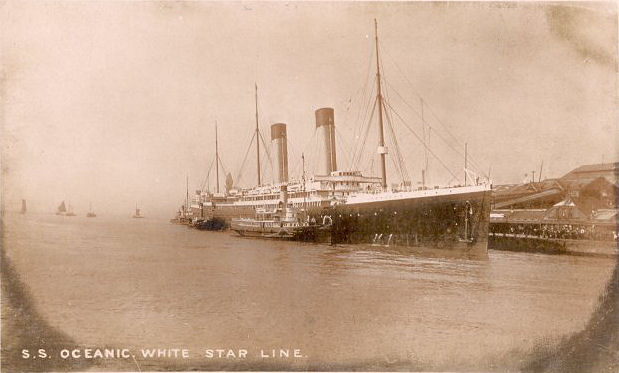
At first, it was thought that
the storm had lifted Oceanic off the rocks and carried her to deeper
waters to sink, but it was later discovered that the storm had pounded the ship
against the rocks so that she was reduced to smithereens. Her remains lay
scattered in relatively shallow water. Breaking-up on the spot would be
completed in 1924.
Smith, Slayter, and Blair
were all court-martialed. Comparing Oceanic's log and the ship's last
movements as witnessed by the inhabitants of Foula and noting their
inconsistencies, Smith and Slayter were exonerated and Blair was let off with a
mild reprimand. The hearings resulted in changes in the armed merchant
cruisers' administration, and the mercantile officers were given more
responsibility.
Copyright © 2003 Darrel R. Hagberg
All rights reserved.
Updated on July 23 2006









